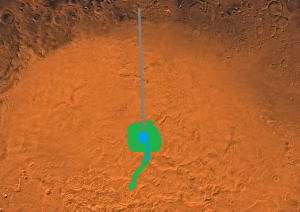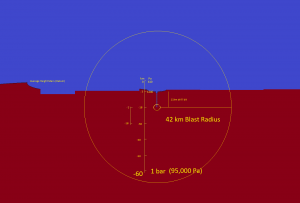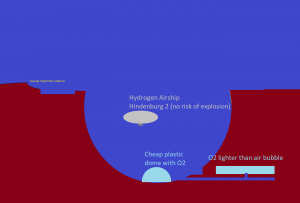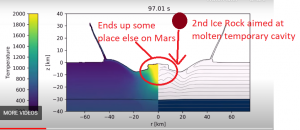According to my calculations Martian Scale Height of 11.1km means that we are only 30km away from reaching 0.7 bars of air pressure from the Northern Basin or Hellas Planitia. Can we deflect a comet or more to the same spot on such an elevation on Mars to excavate 30km? Then the water from the comet can produce a liquid water lake for us since it will be within the Armstrong Limit now and we can introduce algae and plant life in cheap greenhouses to slowly terraform Mars as a micro climate via photosynthesis to convert the CO2 to O2 slowly. The comet the size of Hailey's would also contribute 1% to the Martian atmosphere with gas. While negilgible on it's own if this becomes a regular occurance, 100 comet strikes will double the Martian atmospheric pressure and air density. This also means the future Micro Climate Craters can gradually be shallower and shallower eventually only needing to be 15km deep in the future.
Could we deflect enough comets to excavate 30km from the Northern Basin where it's-7km from the datum? Or maybe Hellas Planitia. We could settle at the bottom of such a cavity and use airships for transportation without risk of explosion in the CO2 atmosphere, we could also live without the need of airlocks at our doors to maintain an air pressure bubble within the Armstrong Limit and we will have supply of drinking soda water and water for rocket fuel via electrolysis producing both breathable oxygen gas as well as hydrogen for rocket fuel and airships. We wont need full pressure space suits just flimsy stratapause type ones.





Could we deflect enough comets to excavate 30km from the Northern Basin where it's-7km from the datum? Or maybe Hellas Planitia. We could settle at the bottom of such a cavity and use airships for transportation without risk of explosion in the CO2 atmosphere, we could also live without the need of airlocks at our doors to maintain an air pressure bubble within the Armstrong Limit and we will have supply of drinking soda water and water for rocket fuel via electrolysis producing both breathable oxygen gas as well as hydrogen for rocket fuel and airships. We wont need full pressure space suits just flimsy stratapause type ones.





Last edited:


